TRAVIRONMENT: Climatitis, Sea to Sea.📌♨️☟
VamoScience & Tech. (Premise).
Travel vs. Climate: Tonic or Toxic?
Travel in a Grave New World:
Red Turns Green and Brown.
(4/30/23)—Parting Florida’s red seas is one thing, seeing springtime green turn murky brown quite another altogether. ☟
Just ask travelers to Key West these days, who find fine Straits and Gulfside beaches blobbed with tons of bloomin’ seaweed—green going browner by the day, stinking to coral reefer heaven.
“We’d have to muck through 75 yards of the stuff before making clear water,” sniffed one visiting 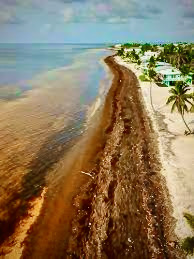 couple. “And forget about swimming with that strong a smell.”
couple. “And forget about swimming with that strong a smell.”
Sour grapes? No, more like rotten eggs—such is the gassy stench emitted from the beached vegetation, which is more specifically known as Sargassum, a grab-bag term for brown algae.
It’s product of the Great Atlantic Sargassum Seaweed Belt, a messy mass that drifts westward yearly from African shores to tropical areas about the Caribbean Sea and Gulf of Mexico, just as the high spring/ summer travel season arrives.
While the vast ocean blooms can nourish and protect marine mammals, fish and birds at sea, they grow toxic once landing ashore—sucking oxygen from the waters, forming dead zones, provoking a slew of respiratory ailments. Along shorelines, the Sargassum piles up in smelly mounds, becoming rapidly more dangerous to surf life and beachgoers alike.
Tracked monthly-to-annually since 2011, the rotting seaweed has already piled up a record volume this 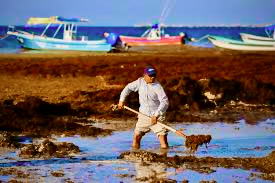 early in 2023, projected by oceanographers to increase in the years ahead, depending upon climate variabilities and a warming Atlantic Ocean. Meantime, the stinking sludge is costly to clean up, and heavy equipment to do so poses a crushing threat to sea turtles and other vulnerable coastal species.
early in 2023, projected by oceanographers to increase in the years ahead, depending upon climate variabilities and a warming Atlantic Ocean. Meantime, the stinking sludge is costly to clean up, and heavy equipment to do so poses a crushing threat to sea turtles and other vulnerable coastal species.
But what’s dun is dun, and looks like it has to be done away with, if the Keys and Caribbean beaches hope to see a healthy greening in the busy travel/tourism season ahead. (MTC…) ☟![]()
When Red Menace Stormed the Beaches.
The tide was in, and it had Florida redlining at the time. 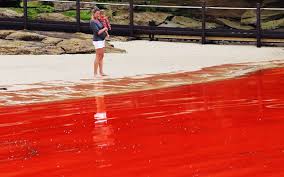
For much of that 2018 summer travel season, its Gulf Coast had been invaded by a bloomin’ sea of algae. Namely, microbes called Karenia bravis have accumulated along the Sunshine State’s tourism-dependent western shores, forming a red tide that has extended some 150 miles, from Pinellas down to Collier Counties.
This natural phenomenon has been occurring forever and a day around the Gulf of Mexico, including South Texas, Galveston to Padre Island, nearly every summer. Some blooms are toxic, some are not—the latter usually being smaller, beneficial for sea creature food. But HABS (harmful algal blooms) have been on the rise along Florida’s Gulf Coast, and currently are the region’s worst in over a decade, possibly the worst since 1947.
Bloom or Doom.
Today’s toxic algae buildup actually began in October, 2017, and has increased in size and intensity ever since. Indeed, the red tide is clogging waters, killing sea/wildlife, and creating a stench that is driving precious visitors away from the very beaches they have come to enjoy. In some cases leaving the 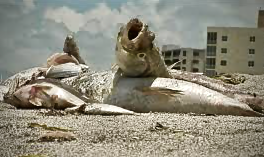 picturesque coastline strewn with rotting carcasses of sea turtles (50), manatees (80), dolphins, even a 26-foot juvenile whale shark. While inland canals and rivers are sickeningly solid with fish kills plumes.
picturesque coastline strewn with rotting carcasses of sea turtles (50), manatees (80), dolphins, even a 26-foot juvenile whale shark. While inland canals and rivers are sickeningly solid with fish kills plumes.
Further, such tides—rust to pink to blood red—throw off chemicals that can wreak havoc on human respiratory systems: smell and tingling in the nose, throat and lungs. “I can feel and taste it in the air,” says one Sarasota restaurateur, “real spicy and peppery that stings the back of your throat”.
All told, it’s a wildlife massacre of massive proportions, leaving sea mammals in seizures or comatose, and “the long-term effects are worrisome at best—at worst, a killer.”
On Florida tourism, that is, as visitors have already been cancelling and re-routing trips, or fleeing the coast and/or state altogether, fearful of nearing its fouled beaches. With the upcoming winter ‘snowbird’ season in the balance, no one is sure exactly when the blooms are supposed to dissipate, distasteful news spreading like the algae itself. Whereas residents can only wait the scourge out with clothespinned noses.
Feeding the Beast.
Thriving in saline waters, the red tide feeds on sun during the day; by night its microbes descend to the sea floor after nutrients that have sunk and dissolved. Also supplying the bloom is runoff (fertilizer, etc.) from cattle farms and developmental sprawl around freshwater Oak Ockeechobee, turning inland waterways into thick green pea soup. That pollution is met by Gulf waves that can release irritating brevetoxins into the air, while accumulating in clams, mollusks and oysters that aren’t necessarily susceptible, but filter feed vulnerable sealife (and humans) that ingest them.
Aggravated by warmer temperatures, heavier rains and hurricanes, Florida’s mild western coast 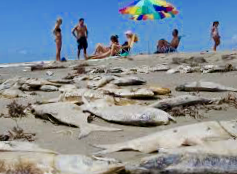 environment fosters increasingly prime conditions for red-tide algae blown ashore by Gulf winds: a combination of light, salinity, chemistry, currents and nutrient-rich bacteria. For instance, studies have shown that blooms between 1994-2002 were already 13-18 fold more abundant than those of 1954-1963, and have only magnified.
environment fosters increasingly prime conditions for red-tide algae blown ashore by Gulf winds: a combination of light, salinity, chemistry, currents and nutrient-rich bacteria. For instance, studies have shown that blooms between 1994-2002 were already 13-18 fold more abundant than those of 1954-1963, and have only magnified.
Little wonder Florida conservation agencies are in a state of emergency, scrambling to secure funding for efforts to fight and contain the algae scourge, moreso than during the previous 30 years of tracking these red tides. Approaches to waging ‘Red War’ include employing macro algae and/or Diatom planktons to compete for those nutrients, thereby inhibiting Karenia brevis growth. Moreover, increased sensing of the fluid dynamic of Gulf of Mexico chemistry and micro organisms is in the plans.
Fleeing the Beast.
In the meantime, the state’s Gulf Coast tourism industry struggles to stem the visitor (exit) tide. Authorities are providing information on health concerns and remedial resources, posting warning notices on beach access and water conditions, and launching cleanup operations (with tourist tax funding).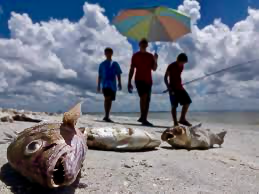
The agency, Visit Florida aims to buttress tourism-related businesses that are seeing at least 6% drops in foot traffic thus far. VF is also promoting alternative Florida destinations that aren’t along affected Gulf Coast beaches and communities (e.g., coasting gladly toward the Atlantic side until this whole mess blows over?). For its part, Sarasota is even using clams and lobsters in essence to eat away at all the accumulated, threatening algae.
Where to Go, What to Do?
Human caused or natural? The U.S. National Office for Harmful Algae Blooms says, “a little of both.” In any case, this red tide appears to be one more symptom of broader climate change. So Vamigré will keep a close eye (and nose) on these stormy Sunshine State developments—monitoring whether Florida continues to ‘stand its ground’ over these and other travel/tourism trevails. Alas, on the other side comes the algae scourge along Mexico’s beaches—not red necessarily, yet bothersome just the same.
That is, whether it ultimately passes the Vamigré smell test, and where we go from there…
Seeing Red, Sea to Sea to Aussies.
![]() Seeing red as well these devastatingly broiling days are southeast coastal Australians, from Brisbane and Sydney down to Melbourne, New South Wales to Victoria. Fierce, shifting winds, bone dryness and record intense heat have combined to create a blast furnace across much of the country, but particularly along the Tasman seaboard (e.g., fire-encircled Mallacoota).
Seeing red as well these devastatingly broiling days are southeast coastal Australians, from Brisbane and Sydney down to Melbourne, New South Wales to Victoria. Fierce, shifting winds, bone dryness and record intense heat have combined to create a blast furnace across much of the country, but particularly along the Tasman seaboard (e.g., fire-encircled Mallacoota).
So tens of thousands have been fleeing a “tourist leave zone” in cutoff Victoria towns, under mandatory emergency evacuation orders. Australian military have been removing (by land 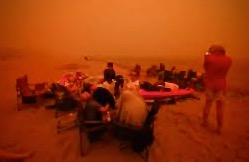 and sea) some 4,000 fire-trapped persons—many gas masked, huddled on beaches—around places like Bairnsdale and Batemans Bay, amidst Princess Highway’s suffocating traffic gridlock. It is the nation’s largest peacetime evacuation in history.
and sea) some 4,000 fire-trapped persons—many gas masked, huddled on beaches—around places like Bairnsdale and Batemans Bay, amidst Princess Highway’s suffocating traffic gridlock. It is the nation’s largest peacetime evacuation in history.
The escalating brushfires, horrendous flame walls torching some 15 million acres, are now consuming even hotter and harder forest lands. The blazes have killed 27 since September, with 17 missing and over 1,400 homes lost in NSW alone. Billowing smoke blankets have also drifted 1,000 miles across the Tasman Sea to New Zealand, turning stunning sky-blue landscapes an eerie yellow—staining snowy glaciers like power sprayed clinkers, North Island and South.
Worse, this unprecedented fire season-from-hell threatens to ravage Australia for two more 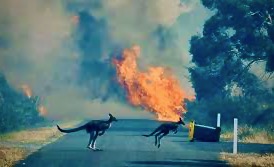 months at least (particularly in coming days), with no rain predicted anytime soon. Heaven help the country’s koalas and kangaroos. Surely Vamigré will follow these catastrophic developments, not to mention political fallout from the utter Worse, this unprecedented fire season-from-hell threatens to ravage Australia for two more months at least (particularly in coming days), with no rain predicted anytime soon. Heaven help the country’s koalas and kangaroos. Surely Vamigré will follow these catastrophic developments, not to mention political fallout from the utter lack of preparation and resources to better protect visitors and residents alike, and defend the vulnerable, now fire devastated towns. (MTC…) ☟
months at least (particularly in coming days), with no rain predicted anytime soon. Heaven help the country’s koalas and kangaroos. Surely Vamigré will follow these catastrophic developments, not to mention political fallout from the utter Worse, this unprecedented fire season-from-hell threatens to ravage Australia for two more months at least (particularly in coming days), with no rain predicted anytime soon. Heaven help the country’s koalas and kangaroos. Surely Vamigré will follow these catastrophic developments, not to mention political fallout from the utter lack of preparation and resources to better protect visitors and residents alike, and defend the vulnerable, now fire devastated towns. (MTC…) ☟
☟ C.I.P. II> Smoke Gets In Your Skies.
![]() Looking far further westward, it appears skies were beginning to clear some along the Pacific coast after a summer of relentless grassland and forest fires—from British Columbia down to Santa Barbara to Baja.
Looking far further westward, it appears skies were beginning to clear some along the Pacific coast after a summer of relentless grassland and forest fires—from British Columbia down to Santa Barbara to Baja.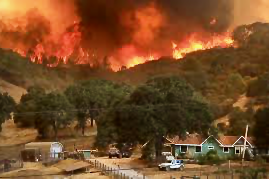
Overall, 2017 had wrought perhaps the most devastating wildlife season on record, throughout the western U.S. And the smoke of so many blazes had generated choking orange-gray skies over the most beautiful and cherished of places: Vancouver, Puget Sound and Oregon, not least California’s Shasta region and Yosemite National Park (per Ferguson Fire).
The Golden State itself has continued to suffer the most severe and prolonged seasons to date. Wind events and widespread fires have ravaged north state, beginning with the Carr Fire in and around Redding. But the most hellacious blaze had followed; ‘Mendocino Complex’ burned 410,182+ acres, its fore- and backfires ravaging communities, subdivisions and wildlife, Mendocino to Lake Counties, including the Napa-Sonoma wine country. Alas, surpassing even that in ferocity have since been the Camp and Kincade fires—the former now being California’s worst on record.
A confluence of the River and Ranch Fires, this Golden State’s all-time largest and most lethal wildfires have forced mass mandatory evacuations. It has torched whole neighborhoods and trailer parks, burning mansions and estates for a month and more (though by now is some 90% contained)—also taking the lives of heroic firefighters and wildlife everywhere in its path.
The Eyes Have It.
Resulting from these West Coast infernos are hazy goulash skies of burned trees, vegetation, toxic charred building materials and red-colored fire retardant sprayed by firefighting tanker planes. 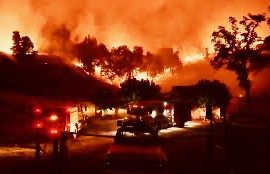
Mix that air pollution with a perennial coastal fog pattern, and the entirety of Northern California fell under an inescapable umbrella of gross ‘Campfire’ smoke. With it has come the ashy smell, hacking coughs and burning, watery eyes that even N95 face masks cannot fully filter away.
The particulate-heavy, ozone-forming smoke pollution is beyond lung irritating to downright hazardous for kids, seniors and those with preexisting respiratory conditions like asthma, et cetera. 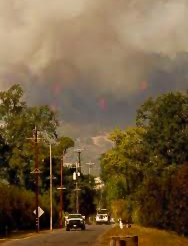
Only now are these cinnamon oatmealy skies beginning to clear. Yet protracted exposure to lingering unsafe air quality levels is relatively uncharted territory anywhere outside of India and China (although Italy and Greece are rapidly gaining on that pollution plagued ground).
Then again, the Golden State and broader western U.S. will continue to draw visitors from the world over, no matter how hot, red flagged it gets out there. And do some ‘salvetory’ visiting when possible…and environmentally helpful.
Thus Vamigré will be all over any such overheated effects of ‘climatitis’, so long as we continue seeing red…
